Exploring the Biological Activity of Phytocannabinoid Formulations for Skin Health Care: A Special Focus on Molecular Pathways
Abstract
1. Introduction
- -
- Endocannabinoids, which are naturally synthesized in the human body. This class includes anandamide (EAE) and 2-arachidonoylglycerol (2-AG), which interact with the endocannabinoid system (ECS).
- -
- Phytocannabinoids (pCBs), which are produced by plants. Among the most studied pCBs are Δ9-tetrahydrocannabinol (THC) and cannabidiol (CBD), though many others have been identified and are currently under investigation for their potential therapeutic effects.
- -
2. Results and Discussion
2.1. Evaluation of Cellular Viability of Cell Lines Exposed to Stress-Inducing Agents: Optimization of the Experimental Conditions
2.1.1. H2O2
2.1.2. TPA
2.2. Evaluation of Gene Expression Markers in Cell Lines
2.2.1. Molecular Insights into the Pro-Inflammatory Modulation by F1CR1, F1CR2, F2CAA, and F3TAC Formulations in Pre-Treatment and Treatment Conditions
2.2.2. Molecular Insights into the Anti-Inflammatory Effects of F1CR1, F1CR2, F2CAA and F3TAC Formulations in Pre-Treatment and Treatment Conditions
2.2.3. Molecular Insights into the Structural Modulation by F1CR1, F1CR2, F2CAA and F3TAC Formulations in Pre-Treatment and Treatment Conditions
2.2.4. Molecular Evaluation of Cannabinoid Receptor Modulation by F1CR1, F1CR2, F2CAA and F3TAC Formulations in Pre-Treatment and Treatment Scenarios
2.3. In Vivo Efficacy Assays in Human Volunteers: A Proof of Concept
3. Materials and Methods
3.1. Materials
3.2. Cell Line Culture Conditions
3.3. Evaluation of Cellular Viability of Cell Lines Exposed to Stress-Inducing Agents
3.4. Formulation Development and Analysis
3.5. Evaluation of pCBs Effect in Pre-Treatment and Treatment Conditions
- Pre-treatment effect
- Treatment effect
3.6. Real-Time Polymerase Chain Reaction (RT-qPCR)
3.7. In Vivo Efficacy and Safety Studies
4. Conclusions
Supplementary Materials
Author Contributions
Funding
Institutional Review Board Statement
Informed Consent Statement
Data Availability Statement
Conflicts of Interest
Abbreviations
References
- Hourfane, S.; Mechqoq, H.; Bekkali, A.Y.; Rocha, J.M.; El Aouad, N. A Comprehensive Review on Cannabis Sativa Ethnobotany, Phytochemistry, Molecular Docking and Biological Activities. Plants 2023, 12, 1245. [Google Scholar] [CrossRef] [PubMed]
- Legare, C.A.; Raup-Konsavage, W.M.; Vrana, K.E. Therapeutic Potential of Cannabis, Cannabidiol, and Cannabinoid-Based Pharmaceuticals. Pharmacology 2022, 107, 131–149. [Google Scholar] [CrossRef] [PubMed]
- Radwan, M.M.; Chandra, S.; Gul, S.; ElSohly, M.A. Cannabinoids, Phenolics, Terpenes and Alkaloids of Cannabis. Molecules 2021, 26, 2774. [Google Scholar] [CrossRef] [PubMed]
- Martinelli, G.; Magnavacca, A.; Fumagalli, M.; Dell’Agli, M.; Piazza, S.; Sangiovanni, E. Cannabis Sativa and Skin Health: Dissecting the Role of Phytocannabinoids. Planta Med. 2022, 88, 492–506. [Google Scholar] [CrossRef] [PubMed]
- Bie, B.; Wu, J.; Foss, J.F.; Naguib, M. An Overview of the Cannabinoid Type 2 Receptor System and Its Therapeutic Potential. Curr. Opin. Anaesthesiol. 2018, 31, 407–414. [Google Scholar] [CrossRef]
- Scheau, C.; Badarau, I.A.; Mihai, L.-G.; Scheau, A.-E.; Costache, D.O.; Constantin, C.; Calina, D.; Caruntu, C.; Costache, R.S.; Caruntu, A. Cannabinoids in the Pathophysiology of Skin Inflammation. Molecules 2020, 25, 652. [Google Scholar] [CrossRef]
- Ferreira, B.P.; Costa, G.; Mascarenhas-Melo, F.; Pires, P.C.; Heidarizadeh, F.; Giram, P.S.; Mazzola, P.G.; Cabral, C.; Veiga, F.; Paiva-Santos, A.C. Skin Applications of Cannabidiol: Sources, Effects, Delivery Systems, Marketed Formulations and Safety. Phytochem. Rev. 2023, 22, 781–828. [Google Scholar] [CrossRef]
- Kendall, D.A.; Yudowski, G.A. Cannabinoid Receptors in the Central Nervous System: Their Signaling and Roles in Disease. Front. Cell Neurosci. 2017, 10, 294. [Google Scholar] [CrossRef]
- Zou, S.; Kumar, U. Cannabinoid Receptors and the Endocannabinoid System: Signaling and Function in the Central Nervous System. Int. J. Mol. Sci. 2018, 19, 833. [Google Scholar] [CrossRef]
- Biringer, R.G. Endocannabinoid Signaling Pathways: Beyond CB1R and CB2R. J. Cell Commun. Signal 2021, 15, 335–360. [Google Scholar] [CrossRef]
- Osafo, N.; Yeboah, O.K.; Antwi, A.O. Endocannabinoid System and Its Modulation of Brain, Gut, Joint and Skin Inflammation. Mol. Biol. Rep. 2021, 48, 3665–3680. [Google Scholar] [CrossRef] [PubMed]
- Battista, N.; Di Tommaso, M.; Bari, M.; Maccarrone, M. The Endocannabinoid System: An Overview. Front. Behav. Neurosci. 2012, 6, 19633. [Google Scholar] [CrossRef] [PubMed]
- Coelho, M.P.; Duarte, P.; Calado, M.; Almeida, A.J.; Reis, C.P.; Gaspar, M.M. The Current Role of Cannabis and Cannabinoids in Health: A Comprehensive Review of Their Therapeutic Potential. Life Sci. 2023, 329, 121838. [Google Scholar] [CrossRef]
- Žugić, A.; Martinović, M.; Tadić, V.; Rajković, M.; Racić, G.; Nešić, I.; Koren, A. Comprehensive Insight into Cutaneous Application of Hemp. Pharmaceutics 2024, 16, 748. [Google Scholar] [CrossRef] [PubMed]
- Smith, G.L.; Powell, S. Scientific Evidence for the Cosmetic Skin and Hair Benefits of Hemp-Derived Cannabinoids: A Review. Clin. Dermatol. Open Access J. 2024, 9, 000319. [Google Scholar]
- Wang, L.-L.; Zhao, R.; Li, J.-Y.; Li, S.-S.; Liu, M.; Wang, M.; Zhang, M.-Z.; Dong, W.-W.; Jiang, S.-K.; Zhang, M.; et al. Pharmacological Activation of Cannabinoid 2 Receptor Attenuates Inflammation, Fibrogenesis, and Promotes Re-Epithelialization during Skin Wound Healing. Eur. J. Pharmacol. 2016, 786, 128–136. [Google Scholar] [CrossRef]
- Perez, E.; Fernandez, J.R.; Fitzgerald, C.; Rouzard, K.; Tamura, M.; Savile, C. In Vitro and Clinical Evaluation of Cannabigerol (CBG) Produced via Yeast Biosynthesis: A Cannabinoid with a Broad Range of Anti-Inflammatory and Skin Health-Boosting Properties. Molecules 2022, 27, 491. [Google Scholar] [CrossRef]
- Filipiuc, S.-I.; Neagu, A.-N.; Uritu, C.M.; Tamba, B.-I.; Filipiuc, L.-E.; Tudorancea, I.M.; Boca, A.N.; Hâncu, M.F.; Porumb, V.; Bild, W. The Skin and Natural Cannabinoids–Topical and Transdermal Applications. Pharmaceuticals 2023, 16, 1049. [Google Scholar] [CrossRef]
- Turcotte, C.; Blanchet, M.-R.; Laviolette, M.; Flamand, N. The CB2 Receptor and Its Role as a Regulator of Inflammation. Cell. Mol. Life Sci. 2016, 73, 4449–4470. [Google Scholar] [CrossRef]
- Oláh, A.; Tóth, B.I.; Borbíró, I.; Sugawara, K.; Szöllõsi, A.G.; Czifra, G.; Pál, B.; Ambrus, L.; Kloepper, J.; Camera, E.; et al. Cannabidiol Exerts Sebostatic and Antiinflammatory Effects on Human Sebocytes. J. Clin. Investig. 2014, 124, 3713–3724. [Google Scholar] [CrossRef]
- Sangiovanni, E.; Fumagalli, M.; Pacchetti, B.; Piazza, S.; Magnavacca, A.; Khalilpour, S.; Melzi, G.; Martinelli, G.; Dell’Agli, M. Cannabis Sativa L. Extract and Cannabidiol Inhibit in Vitro Mediators of Skin Inflammation and Wound Injury. Phytother. Res. 2019, 33, 2083–2093. [Google Scholar] [CrossRef] [PubMed]
- Petrosino, S.; Verde, R.; Vaia, M.; Allarà, M.; Iuvone, T.; Di Marzo, V. Anti-Inflammatory Properties of Cannabidiol, a Nonpsychotropic Cannabinoid, in Experimental Allergic Contact Dermatitis. J. Pharmacol. Exp. Ther. 2018, 365, 652–663. [Google Scholar] [CrossRef]
- Casares, L.; García, V.; Garrido-Rodríguez, M.; Millán, E.; Collado, J.A.; García-Martín, A.; Peñarando, J.; Calzado, M.A.; de la Vega, L.; Muñoz, E. Cannabidiol Induces Antioxidant Pathways in Keratinocytes by Targeting BACH1. Redox Biol. 2020, 28, 101321. [Google Scholar] [CrossRef] [PubMed]
- Styrczewska, M.; Kostyn, A.; Kulma, A.; Majkowska-Skrobek, G.; Augustyniak, D.; Prescha, A.; Czuj, T.; Szopa, J. Flax Fiber Hydrophobic Extract Inhibits Human Skin Cells Inflammation and Causes Remodeling of Extracellular Matrix and Wound Closure Activation. Biomed. Res. Int. 2015, 2015, 862391. [Google Scholar] [CrossRef]
- Atalay, S.; Jarocka-Karpowicz, I.; Skrzydlewska, E. Antioxidative and Anti-Inflammatory Properties of Cannabidiol. Antioxidants 2019, 9, 21. [Google Scholar] [CrossRef]
- Palmieri, B.; Laurino, C.; Vadalà, M. A Therapeutic Effect of Cbd-Enriched Ointment in Inflammatory Skin Diseases and Cutaneous Scars. Clin. Ter. 2019, 170, e93–e99. [Google Scholar] [CrossRef] [PubMed]
- Giacoppo, S.; Mandolino, G.; Galuppo, M.; Bramanti, P.; Mazzon, E. Cannabinoids: New Promising Agents in the Treatment of Neurological Diseases. Molecules 2014, 19, 18781–18816. [Google Scholar] [CrossRef]
- Donvito, G.; Nass, S.R.; Wilkerson, J.L.; Curry, Z.A.; Schurman, L.D.; Kinsey, S.G.; Lichtman, A.H. The Endogenous Cannabinoid System: A Budding Source of Targets for Treating Inflammatory and Neuropathic Pain. Neuropsychopharmacology 2018, 43, 52–79. [Google Scholar] [CrossRef]
- Tóth, K.F.; Ádám, D.; Bíró, T.; Oláh, A. Cannabinoid Signaling in the Skin: Therapeutic Potential of the “C(Ut)Annabinoid” System. Molecules 2019, 24, 918. [Google Scholar] [CrossRef]
- Baswan, S.M.; Klosner, A.E.; Glynn, K.; Rajgopal, A.; Malik, K.; Yim, S.; Stern, N. Therapeutic Potential of Cannabidiol (CBD) for Skin Health and Disorders. Clin. Cosmet. Investig. Dermatol. 2020, 13, 927–942. [Google Scholar] [CrossRef]
- Martins, A.M.; Gomes, A.L.; Vilas Boas, I.; Marto, J.; Ribeiro, H.M. Cannabis-Based Products for the Treatment of Skin Inflammatory Diseases: A Timely Review. Pharmaceuticals 2022, 15, 210. [Google Scholar] [CrossRef] [PubMed]
- Cialdai, F.; Risaliti, C.; Monici, M. Role of Fibroblasts in Wound Healing and Tissue Remodeling on Earth and in Space. Front. Bioeng. Biotechnol. 2022, 10, 958381. [Google Scholar] [CrossRef] [PubMed]
- Mazzantini, C.; El Bourji, Z.; Parisio, C.; Davolio, P.L.; Cocchi, A.; Pellegrini-Giampietro, D.E.; Landucci, E. Anti-Inflammatory Properties of Cannabidiol and Beta-Caryophyllene Alone or Combined in an In Vitro Inflammation Model. Pharmaceuticals 2024, 17, 467. [Google Scholar] [CrossRef] [PubMed]
- Di Meo, C.; Tortolani, D.; Standoli, S.; Angelucci, C.B.; Fanti, F.; Leuti, A.; Sergi, M.; Kadhim, S.; Hsu, E.; Rapino, C.; et al. Effects of Rare Phytocannabinoids on the Endocannabinoid System of Human Keratinocytes. Int. J. Mol. Sci. 2022, 23, 5430. [Google Scholar] [CrossRef] [PubMed]
- Tortolani, D.; Di Meo, C.; Standoli, S.; Ciaramellano, F.; Kadhim, S.; Hsu, E.; Rapino, C.; Maccarrone, M. Rare Phytocannabinoids Exert Anti-Inflammatory Effects on Human Keratinocytes via the Endocannabinoid System and MAPK Signaling Pathway. Int. J. Mol. Sci. 2023, 24, 2721. [Google Scholar] [CrossRef]
- Szymański, Ł.; Jęderka, K.; Cios, A.; Ciepelak, M.; Lewicka, A.; Stankiewicz, W.; Lewicki, S. A Simple Method for the Production of Human Skin Equivalent in 3D, Multi-Cell Culture. Int. J. Mol. Sci. 2020, 21, 4644. [Google Scholar] [CrossRef]
- Wojtowicz, A.M.; Oliveira, S.; Carlson, M.W.; Zawadzka, A.; Rousseau, C.F.; Baksh, D. The Importance of Both Fibroblasts and Keratinocytes in a Bilayered Living Cellular Construct Used in Wound Healing. Wound Repair. Regen. 2014, 22, 246–255. [Google Scholar] [CrossRef]
- Liu, H.-M.; Cheng, M.-Y.; Xun, M.-H.; Zhao, Z.-W.; Zhang, Y.; Tang, W.; Cheng, J.; Ni, J.; Wang, W. Possible Mechanisms of Oxidative Stress-Induced Skin Cellular Senescence, Inflammation, and Cancer and the Therapeutic Potential of Plant Polyphenols. Int. J. Mol. Sci. 2023, 24, 3755. [Google Scholar] [CrossRef]
- Tak, P.P.; Firestein, G.S. NF-ΚB: A Key Role in Inflammatory Diseases. J. Clin. Investig. 2001, 107, 7–11. [Google Scholar] [CrossRef]
- Radaszkiewicz, K.A.; Beckerová, D.; Woloszczuková, L.; Radaszkiewicz, T.W.; Lesáková, P.; Blanářová, O.V.; Kubala, L.; Humpolíček, P.; Pachernik, J. 12-O-Tetradecanoylphorbol-13-Acetate Increases Cardiomyogenesis through PKC/ERK Signaling. Sci. Rep. 2020, 10, 15922. [Google Scholar] [CrossRef]
- Milando, R.; Friedman, A. Cannabinoids: Potential Role in Inflammatory and Neoplastic Skin Diseases. Am. J. Clin. Dermatol. 2019, 20, 167–180. [Google Scholar] [CrossRef] [PubMed]
- Suryavanshi, S.V.; Kovalchuk, I.; Kovalchuk, O. Cannabinoids as Key Regulators of Inflammasome Signaling: A Current Perspective. Front. Immunol. 2021, 11, 613613. [Google Scholar] [CrossRef] [PubMed]
- Pantelis, P.; Theocharous, G.; Lagopati, N.; Veroutis, D.; Thanos, D.-F.; Lampoglou, G.-P.; Pippa, N.; Gatou, M.-A.; Tremi, I.; Papaspyropoulos, A.; et al. The Dual Role of Oxidative-Stress-Induced Autophagy in Cellular Senescence: Comprehension and Therapeutic Approaches. Antioxidants 2023, 12, 169. [Google Scholar] [CrossRef]
- Terao, R.; Ahmed, T.; Suzumura, A.; Terasaki, H. Oxidative Stress-Induced Cellular Senescence in Aging Retina and Age-Related Macular Degeneration. Antioxidants 2022, 11, 2189. [Google Scholar] [CrossRef] [PubMed]
- Saputra, F.; Kishida, M.; Hu, S.-Y. Oxidative Stress Induced by Hydrogen Peroxide Disrupts Zebrafish Visual Development by Altering Apoptosis, Antioxidant and Estrogen Related Genes. Sci. Rep. 2024, 14, 14454. [Google Scholar] [CrossRef]
- Neagu, M.; Constantin, C. Correction to: Signal Transduction in Immune Cells and Protein Kinases. In Protein Kinase-Mediated Decisions Between Life and Death; Spring: Cham, Switzerland, 2021; p. C1. [Google Scholar]
- Jubaidi, F.F.; Zainalabidin, S.; Taib, I.S.; Abdul Hamid, Z.; Mohamad Anuar, N.N.; Jalil, J.; Mohd Nor, N.A.; Budin, S.B. The Role of PKC-MAPK Signalling Pathways in the Development of Hyperglycemia-Induced Cardiovascular Complications. Int. J. Mol. Sci. 2022, 23, 8582. [Google Scholar] [CrossRef]
- He, S.; Li, Q.; Huang, Q.; Cheng, J. Targeting Protein Kinase C for Cancer Therapy. Cancers 2022, 14, 1104. [Google Scholar] [CrossRef]
- Coelho, P.M.; Duarte, P.A.; Calado, M.; Trigo, G.; Santos, S.; Reis, P.C.; Gaspar, M.M. Cannabinoid-Based Topical Formulations for Skin Disorders. In Proceedings of the European Federation for Pharmaceutical Sciences Annual Meeting, Lisbon, Portugal, 31 May–2 June 2023. [Google Scholar]
- Coelho, P.M.; Duarte, P.A.; Calado, M.; Almeida, J.A.; Trigo, G.; Santos, S.; Reis, P.C.; Gaspar, M.M. Application of Cannabinoids in Cosmeceutical Formulations. In Proceedings of the 5th International Conference on Natural Products Utilization, Varna, Bulgaria, 30 May–2 June 2023. [Google Scholar]
- Heo, S.; Kim, S.; Kang, D. The Role of Hydrogen Peroxide and Peroxiredoxins throughout the Cell Cycle. Antioxidants 2020, 9, 280. [Google Scholar] [CrossRef] [PubMed]
- Liu, C.; Li, H.; Xu, F.; Jiang, X.; Ma, H.; Seeram, N.P. Cannabidiol Protects Human Skin Keratinocytes from Hydrogen-Peroxide-Induced Oxidative Stress via Modulation of the Caspase-1–IL-1β Axis. J. Nat. Prod. 2021, 84, 1563–1572. [Google Scholar] [CrossRef]
- Jordan, J.B.; Smallwood, M.J.; Smerdon, G.R.; Winyard, P.G. Cellular Pre-Adaptation to the High O2 Concentration Used in Standard Cell Culture Confers Resistance to Subsequent H2O2-Induced Cell Death. Antioxidants 2024, 13, 269. [Google Scholar] [CrossRef]
- PubChem Phorbol 12-Myristate 13-Acetate. Available online: https://pubchem.ncbi.nlm.nih.gov/compound/Phorbol-12-myristate-13-acetate (accessed on 22 April 2024).
- Chang, S.N.; Dey, D.K.; Oh, S.T.; Kong, W.H.; Cho, K.H.; Al-Olayan, E.M.; Hwang, B.S.; Kang, S.C.; Park, J.G. Phorbol 12-Myristate 13-Acetate Induced Toxicity Study and the Role of Tangeretin in Abrogating HIF-1α-NF-ΚB Crosstalk In Vitro and In Vivo. Int. J. Mol. Sci. 2020, 21, 9261. [Google Scholar] [CrossRef] [PubMed]
- Kazanietz, M.G.; Cooke, M. Protein Kinase C Signaling “in” and “to” the Nucleus: Master Kinases in Transcriptional Regulation. J. Biol. Chem. 2024, 300, 105692. [Google Scholar] [CrossRef] [PubMed]
- Huang, C.; Zhuo, F.; Han, B.; Li, W.; Jiang, B.; Zhang, K.; Jian, X.; Chen, Z.; Li, H.; Huang, H.; et al. The Updates and Implications of Cutaneous Microbiota in Acne. Cell Biosci. 2023, 13, 113. [Google Scholar] [CrossRef] [PubMed]
- Mayslich, C.; Grange, P.A.; Dupin, N. Cutibacterium Acnes as an Opportunistic Pathogen: An Update of Its Virulence-Associated Factors. Microorganisms 2021, 9, 303. [Google Scholar] [CrossRef]
- Patwardhan, S.V.; Richter, C.; Vogt, A.; Blume-Peytavi, U.; Canfield, D.; Kottner, J. Measuring Acne Using Coproporphyrin III, Protoporphyrin IX, and Lesion-Specific Inflammation: An Exploratory Study. Arch. Dermatol. Res. 2017, 309, 159–167. [Google Scholar] [CrossRef]
- ISO 9001:2015; Quality Management Systems—Requirements. International Organization for Standardization: Geneva, Switzerland, 2015.
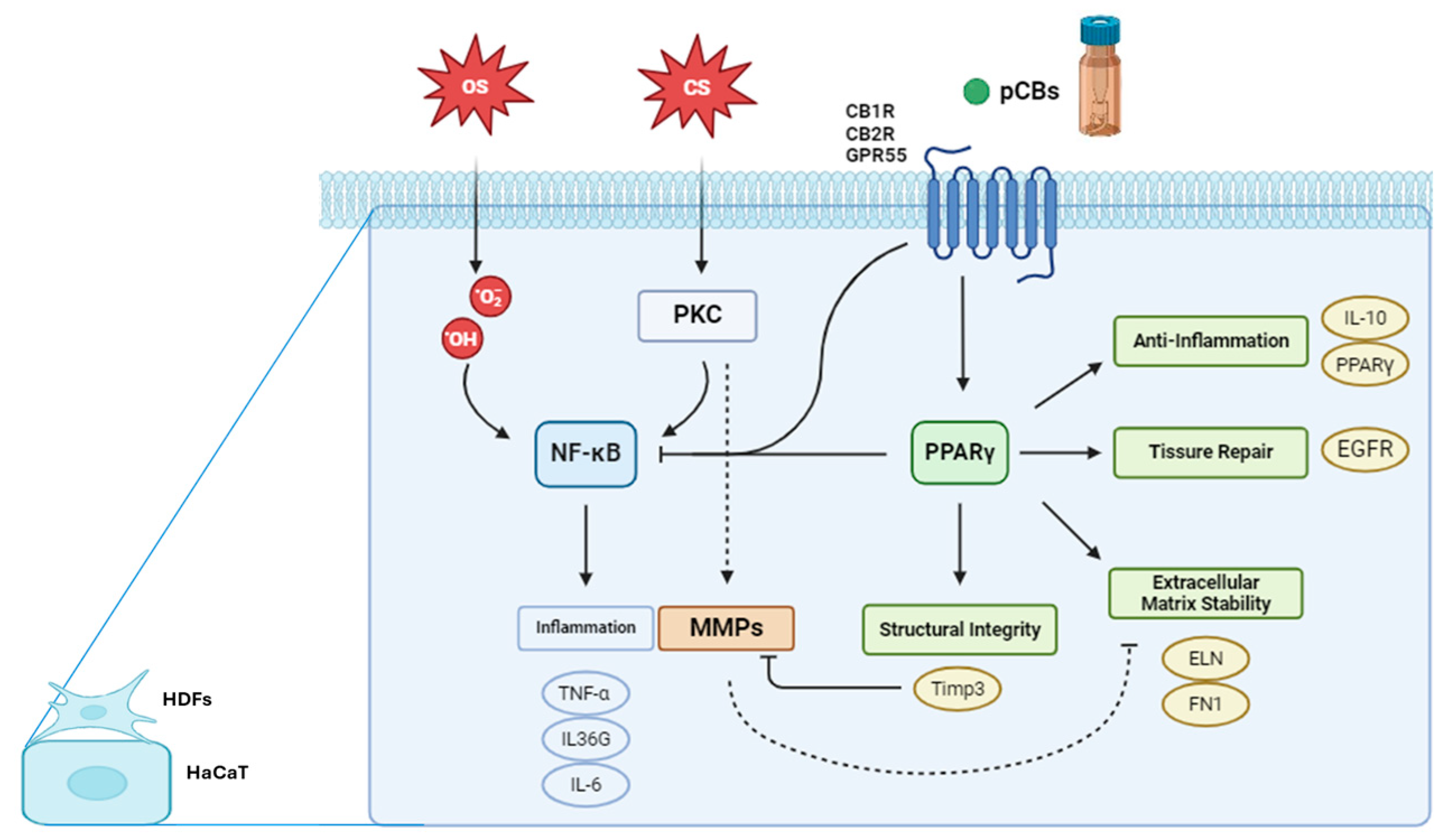
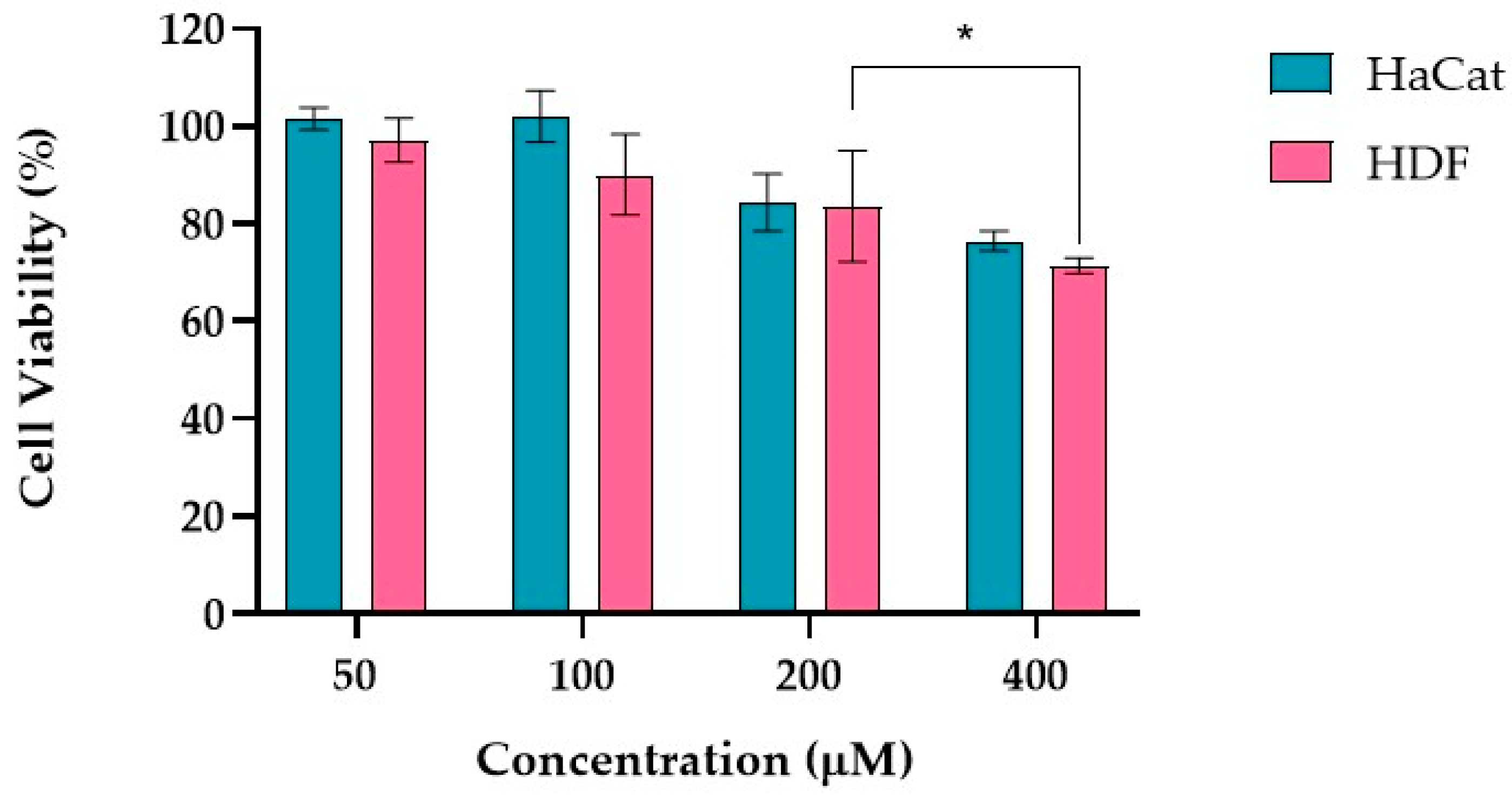

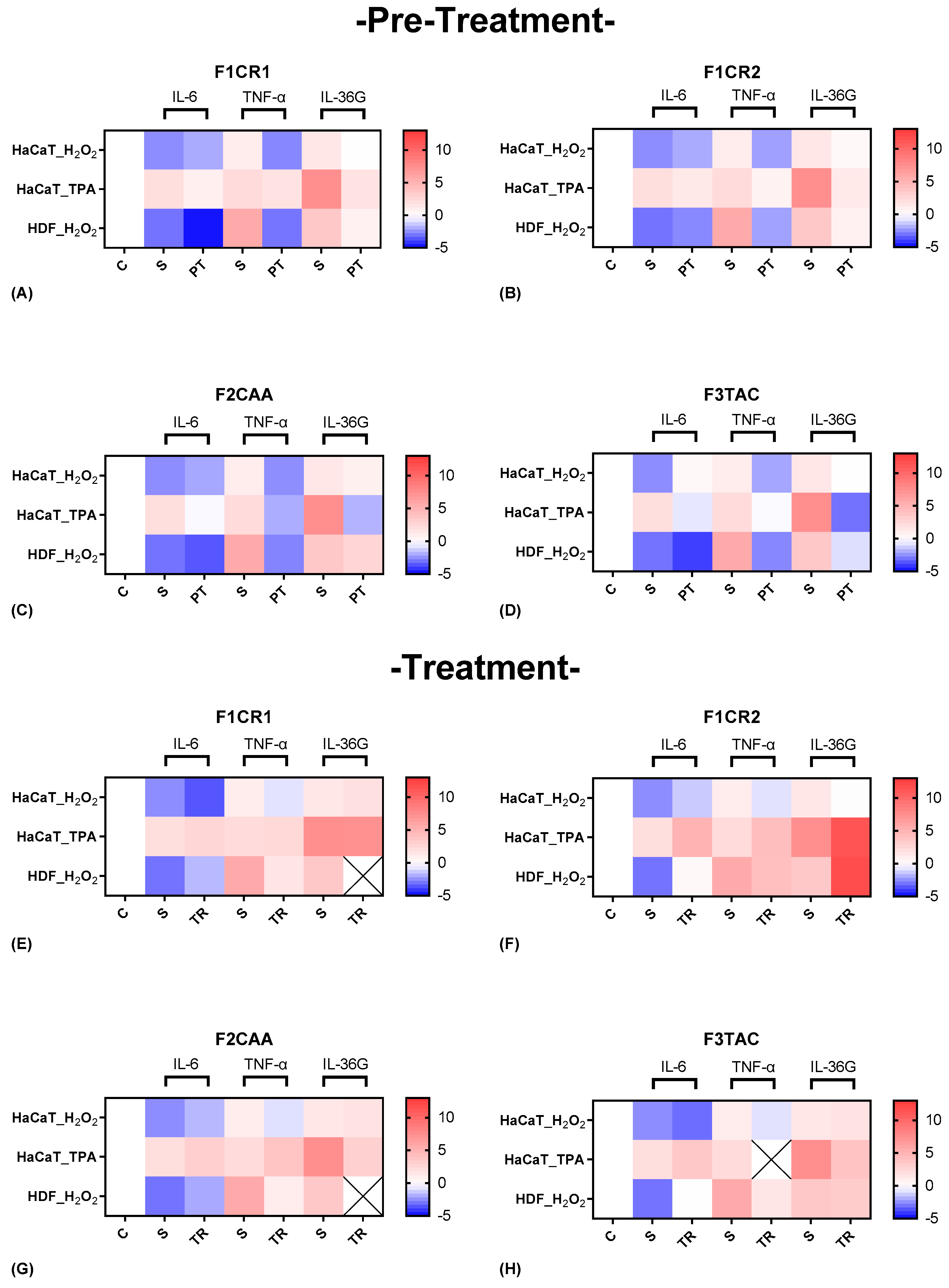
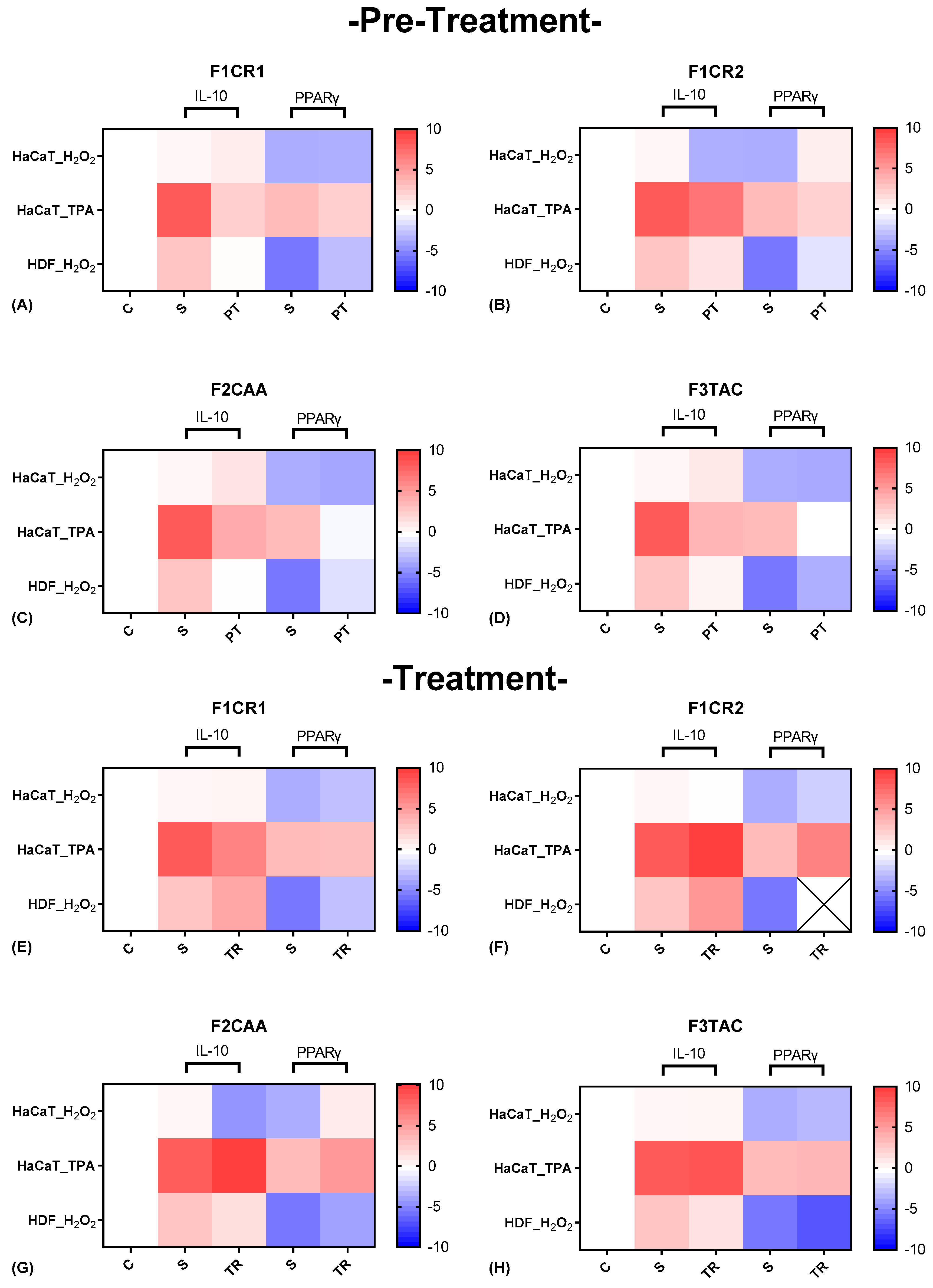
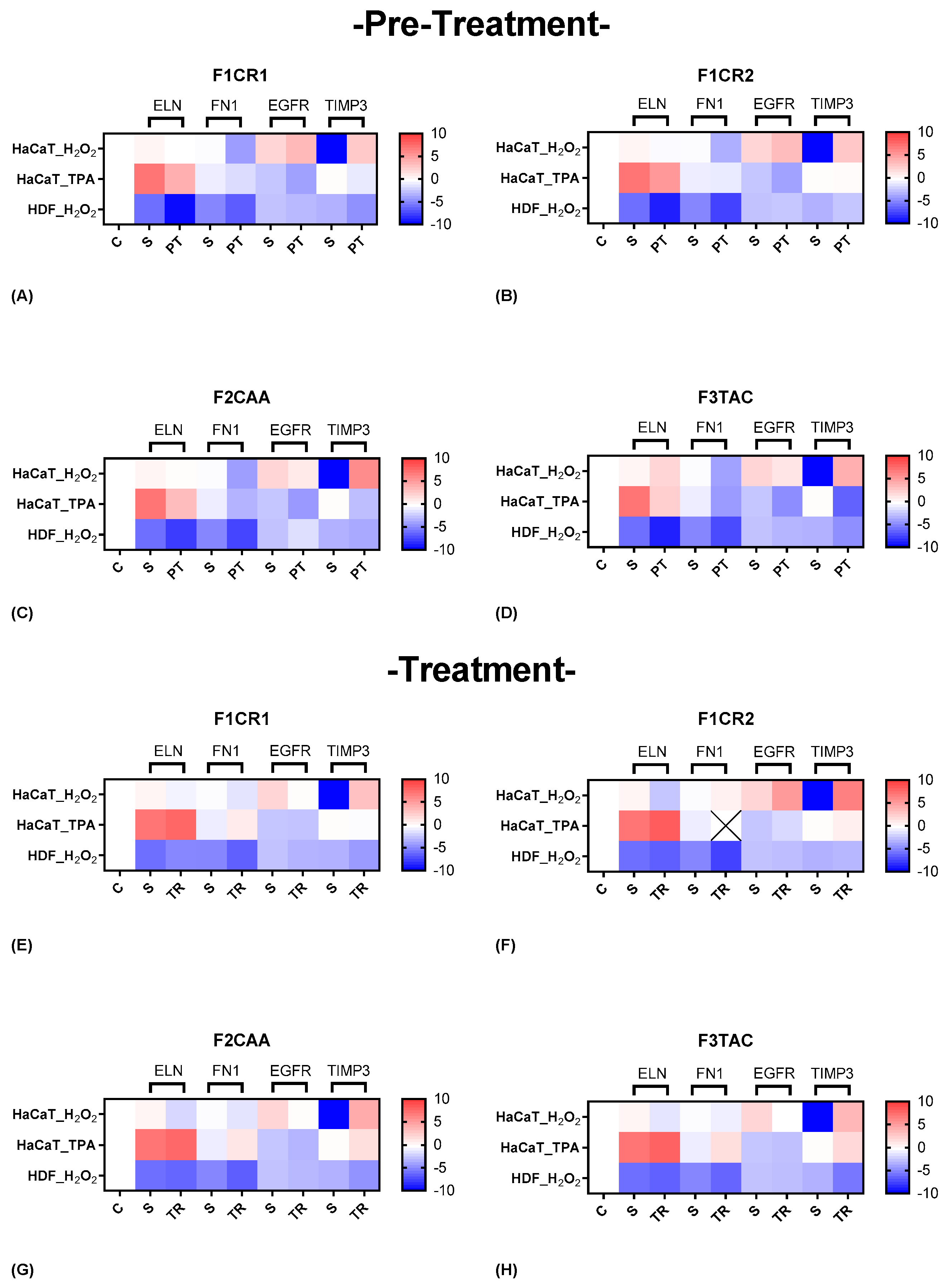
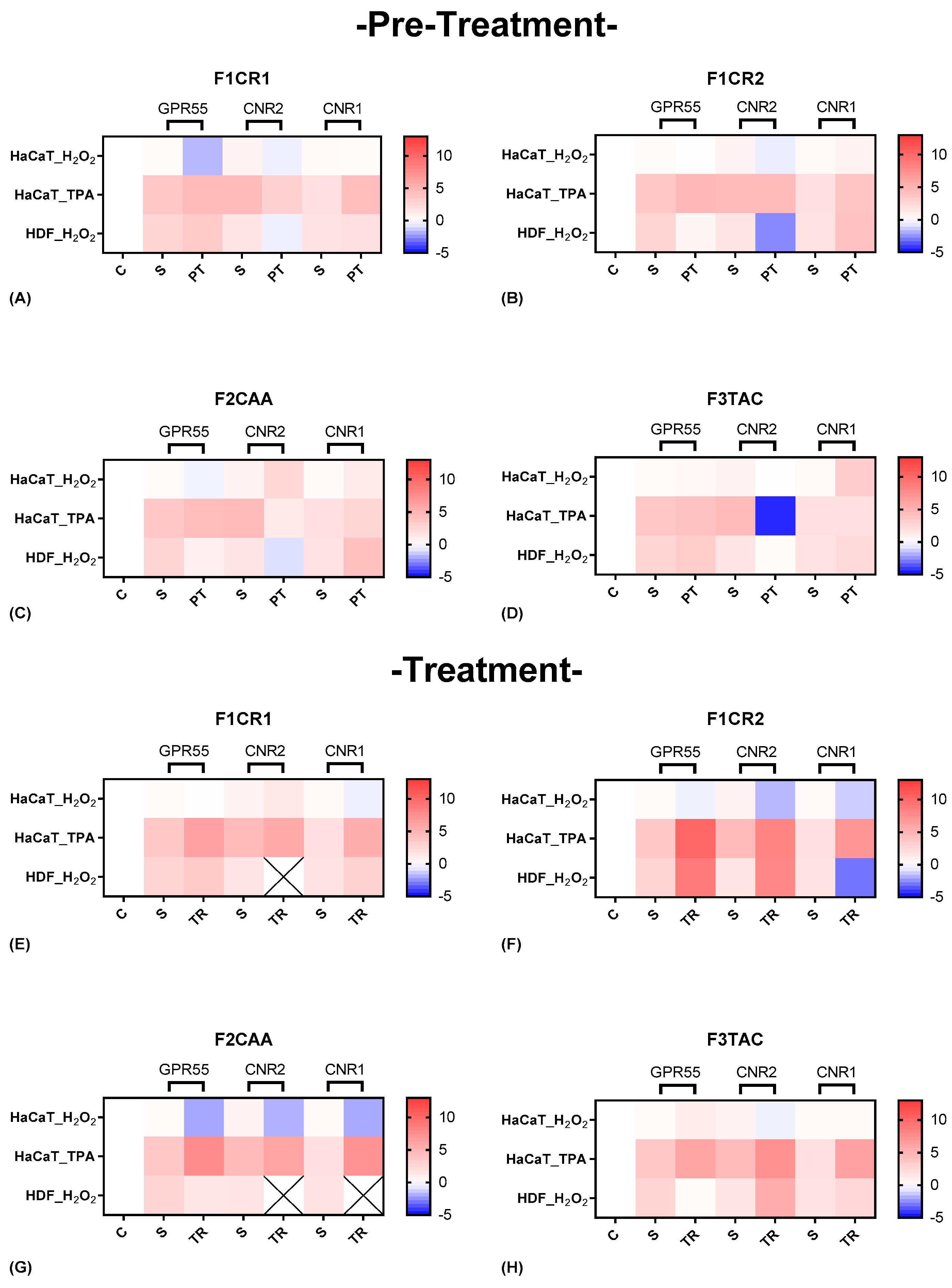

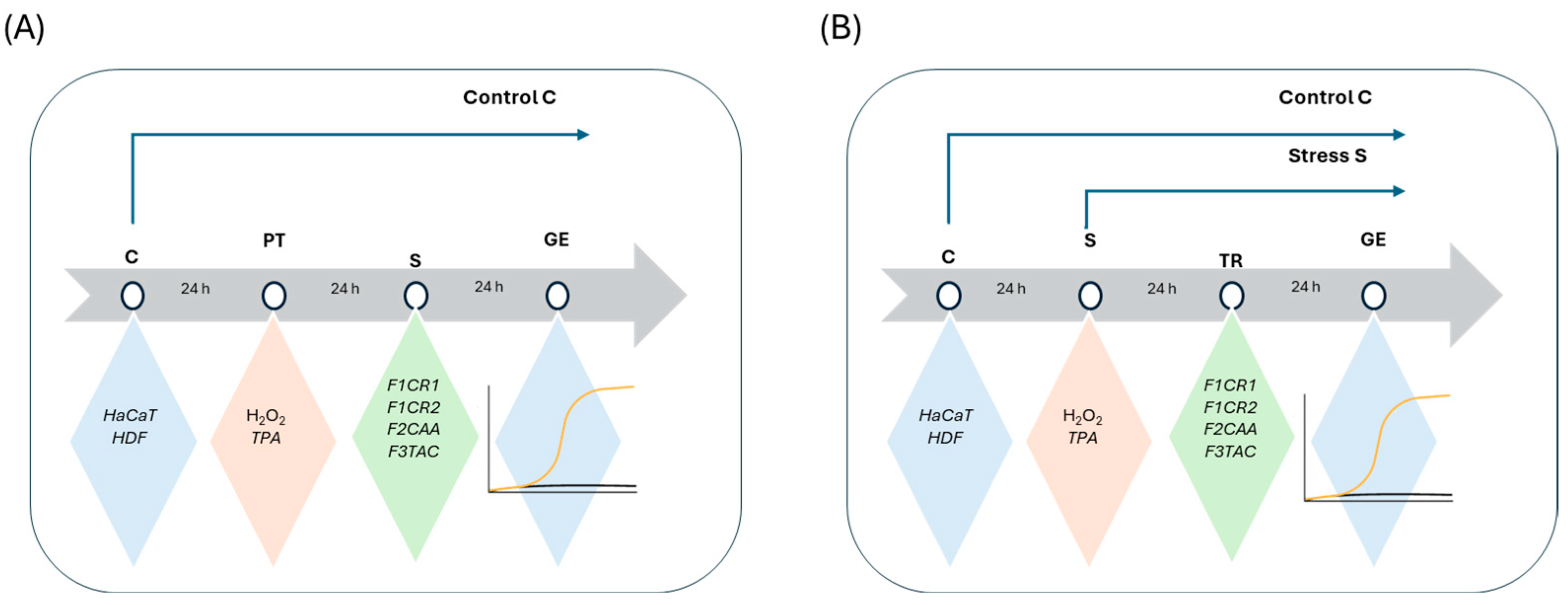
| pCBs | Pro-Inflammation | Anti-Inflammation | Structural | Cann-Receptor | |||||||
|---|---|---|---|---|---|---|---|---|---|---|---|
| CBD | CBG | CBC | PT | T | PT | T | PT | T | PT | T | |
| F1CR1 |  |  | HaCaT and HDF: anti-inflammatory against OS HaCaT: protective against inflammation from TPA stress | HaCaT: complex regulatory action HDF: anti-inflammatory effect (dermis) HaCaT: no significant changes from TPA stress | HaCaT: no significant changes from OS HDF: complex modulation of inflammatory effect | HaCaT: modulation of inflammation and differentiation. HDF: anti-inflammatory action | HaCaT: modulation of ECM production and cell proliferation. HDF: prevent excessive collagen deposition, preventing scarring or fibrosis. | HaCaT: ECM remodeling protects against tissue breakdown and enhances wound healing. | HaCaT: anti-inflammatory action HDF: enhanced wound healing. | HaCaT modulation of the inflammatory action HDF: medium protective action | |
| F1CR2 |  |  | HaCaT: protective against OS, cellular repair. HDF: anti-inflammatory effect in dermal layer HaCaT: protective in reducing inflammation (TPA stress) | HaCaT and HDF: selective modulation of pro-inflammation and inflammation. HaCaT: targeted effect from inflammatory stimuli (TPA stress) | HaCaT: enhanced anti-inflammatory action HDF: complex modulation of anti-inflammatory signals in the dermis | HaCaT: inflammation modulation–shift HDF: anti-inflammatory response HaCaT: protective for inflammation (TPA-stress) | HaCaT: protection against ECM breakdown, reduced fibrosis and scarring. HDF: modulation of matrix production and cell proliferation. | HaCaT and HDF: potential reduction in fibrosis and scarring, protection against ECM degradation. HaCaT: tissue repair and protection against ECM degradation. | HaCaT: enhanced anti-inflammatory and antioxidant effect enhanced response to cannabinoid signaling and potential repair mechanisms. HDF: enhanced cannabinoid signaling | HDF: cellular proliferation and tissue remodeling. | |
| F2CAA |  |  |  | HaCaT: anti-inflammatory and regenerative action for OS and TPA stress. HDF: anti-inflammatory effect | HaCaT: complex modulation of inflammation HDF: anti-inflammatory effect HaCaT: selective modulation of inflammation | HaCaT: anti-inflammatory action for OS HDF: selective modulation of inflammation | HaCaT: modulation of inflammation and metabolic pathway. HDF: protection against OS HaCaT: protection against inflammation (TPA stress) | HaCaT: ECM protection and reduced fibrosis under OS. HDF: ECM production | HaCaT: protection against tissue breakdown HDF: complex modulation of ECM production and protection. HaCaT: tissue repair and protection (TPA stress). | HaCaT: enhanced anti-inflammatory signaling HDF: cell-specific modulation | HaCaT: modulate excessive signaling post-stress. HDF: protective effect |
| F3TAC |  |  | HaCaT: selective modulation of inflammatory pathways HDF: anti-inflammatory effect in dermal layer HaCaT anti-inflammatory action (TPA stress) | HaCaT: limited efficacy HDF: selective modulation of inflammatory responses HaCaT: selective modulation of inflammatory pathway | HaCaT: moderate anti-inflammatory support HDF: complex modulation of anti-inflammatory pathways | HaCaT: limited post-stress effects HDF: stronger impact on anti-inflammatory pathways HaCaT: no significant changes, stress-specific modulation (TPA stress). | HaCaT: enhanced ECM protection HDF: reduced ECM production and remodeling | HaCaT: enhanced protection against ECM degradation HDF: reduced ECM production HaCaT: enhanced ECM production and protection against degradation. | HaCaT: enhanced ECS activation HDF: protective mechanism | HaCaT: selective modulation HDF: enhanced ECS activation | |
| Human Cell Line | Stress Inducers | Range of Concentrations |
|---|---|---|
| HaCaT | H2O2 | 50–400 μM |
| TPA | 5–20 μM | |
| HDF | H2O2 | 50–400 μM |
| Formulations and Creams | CBD | CBG | CBC |
|---|---|---|---|
| F1CR1 | ● | ● | |
| F1CR2 | ● | ● | |
| F2CAA | ● | ● | ● |
| F3TAC | ● | ● |
| Gene Name | Forward Primer | Reverse Primer |
|---|---|---|
| IL-6 | ACCCCTGACCCAACCACAA | GTAGAGTAAGACGCGTCGAAA |
| TNF-α | TGAGGCCAAGCCCTGGTAT | AGTTAGCCGGGCTGATAGAG |
| IL-36G | CCACAAGGCATCTGCATGAG | AAGTCTCGAGTACGCGCAAT |
| PPARγ | AATCAAAGTGGAGCCTGCATCT | TTGAGGGAGTACCGTTAACTT |
| IL-10 | GCATCTACAAAGCCATGAGTGAGT | TCTGTAGTCCCACCGCTGAGA |
| GPR55 | GAGCATCAGCTTCTTCTTGCAAT | ACAGTAGTTTCTTAAGGCGTAC |
| CNR1 | GTTTTGCCTGATGTGGACCAT | ACAAACGAGTCTGTAAAAGGGT |
| CNR2 | GACAAGAAGTTTAGGCGGACACTAT | TAGGAGGGAGTTGTTCTACTCG |
| ELN | AAGCCTCAAAGCTGGATTCG | TGTAGACCCCGCGAAAAC |
| FN1 | AGCCAACCAAGATGCAAATGT | GAATTCACAGACCGGGCGTT |
| TIMP3 | TTCCCTGCGGAGTCGATAAA | TGACATCGCTTTGCGAAAGA |
| EGFR | GGCGTCCGCAAGTGTAAGAA | TCGTAGCATTTATGGAGAGTGAGTCT |
Disclaimer/Publisher’s Note: The statements, opinions and data contained in all publications are solely those of the individual author(s) and contributor(s) and not of MDPI and/or the editor(s). MDPI and/or the editor(s) disclaim responsibility for any injury to people or property resulting from any ideas, methods, instructions or products referred to in the content. |
© 2024 by the authors. Licensee MDPI, Basel, Switzerland. This article is an open access article distributed under the terms and conditions of the Creative Commons Attribution (CC BY) license (https://creativecommons.org/licenses/by/4.0/).
Share and Cite
Trigo, G.; Coelho, M.; Ferreira, C.B.; Melosini, M.; Lehmann, I.S.; Reis, C.P.; Gaspar, M.M.; Santos, S. Exploring the Biological Activity of Phytocannabinoid Formulations for Skin Health Care: A Special Focus on Molecular Pathways. Int. J. Mol. Sci. 2024, 25, 13142. https://doi.org/10.3390/ijms252313142
Trigo G, Coelho M, Ferreira CB, Melosini M, Lehmann IS, Reis CP, Gaspar MM, Santos S. Exploring the Biological Activity of Phytocannabinoid Formulations for Skin Health Care: A Special Focus on Molecular Pathways. International Journal of Molecular Sciences. 2024; 25(23):13142. https://doi.org/10.3390/ijms252313142
Chicago/Turabian StyleTrigo, Guilherme, Mariana Coelho, Carolina Borges Ferreira, Matteo Melosini, Inês Sousa Lehmann, Catarina P. Reis, Maria Manuela Gaspar, and Susana Santos. 2024. "Exploring the Biological Activity of Phytocannabinoid Formulations for Skin Health Care: A Special Focus on Molecular Pathways" International Journal of Molecular Sciences 25, no. 23: 13142. https://doi.org/10.3390/ijms252313142
APA StyleTrigo, G., Coelho, M., Ferreira, C. B., Melosini, M., Lehmann, I. S., Reis, C. P., Gaspar, M. M., & Santos, S. (2024). Exploring the Biological Activity of Phytocannabinoid Formulations for Skin Health Care: A Special Focus on Molecular Pathways. International Journal of Molecular Sciences, 25(23), 13142. https://doi.org/10.3390/ijms252313142









